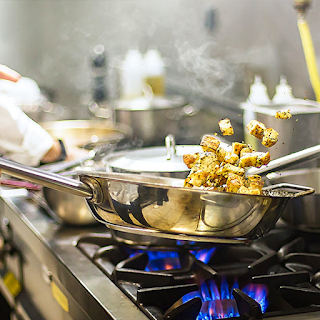Fatty acids and cooking temperature
Vegetable oils
are extracted fats from plants. Although, in principle, other parts of the
plant can be used to extract the oil, in practice it comes almost exclusively
from the seeds. When they are in solid form, they are called fats and in liquid
form, they are considered oils. Before we deliberate about oils and their varying
characteristics, it is worth learning more about the types of fat - which is
the main component of oils.
Saturated fats,
monounsaturated fatty acids (MUFA) and polyunsaturated fatty acids (PUFA)
In the context
of oil composition, we can group them into three broad categories: Oils rich in
saturated fat, monounsaturated and polyunsaturated fatty acids. This
distinction is mainly due to the varying levels of fatty oils and the way the oil
behaves at room temperature: generally, saturated fats are solid, while
unsaturated fats are liquid. As you can now deduce, vegetable oils are the
primary sources of polyunsaturated and monounsaturated fats. These are fats
that, in balance, can contribute to our health and well-being by favoring
circulation and minimizing inflammatory activity in the body. This information
is of relevance due to the fact it helps us discern which oils are suitable for
cooking at varying temperatures and which ones, though nutritious, are not. for
example, they release toxic substances when heated beyond their smoking point.
In this context, we distinguish these three categories of oils:
Oils rich in monounsaturated
fats: Known as "good fats", they are relatively stable oils when
heated, so they should be used at low or medium temperature. Examples: olive
oil, sesame oil (locally known as gingelly) and mustard oil (widely used in
south Asia especially northern India)
Oils rich in polyunsaturated
fats: Are unstable ("brittle"), although healthy, the oils can
produce significant levels of free radicals when exposed to high heat, so they
should not be used for cooking at high temperatures. Most vegetable oils are generally
high in polyunsaturated fats especially sunflower and corn oil.
Oils rich in
saturated fats: as they contain high levels of saturated fatty acids, they
remain stable even when exposed to heat and light, that is, they are oils that
withstand high temperatures and, therefore, are the best for cooking at
relatively high temperatures. Though they enhance the flavor and aroma of the
cooked dishes relatively better, it’s advisable to consume them in moderation. Examples:
coconut oil, butter, ghee.
In recent years,
rice bran oil has stood out most among other edible oils due to its unique
characteristic of having a well-balanced and copacetic fatty acid content. RBO
is widely used in high temperature cooking due to its high smoke point despite
containing one-fourth of saturated fats in its composition. This is an
exception to the rule that only vegetable oils that contain majority of its
content as saturated fats are suitable for high heat cooking. The oil is also recognized
for its antioxidant effects, for helping to control cholesterol, glucose and
blood pressure. Studies link regular and moderate intake of rice bran oil to
lower risk of obesity and cognitive decline.


Comments
Post a Comment